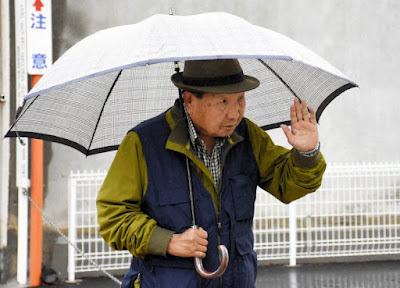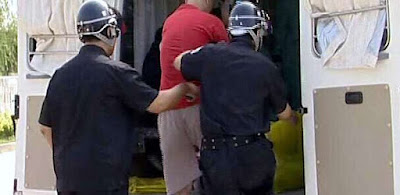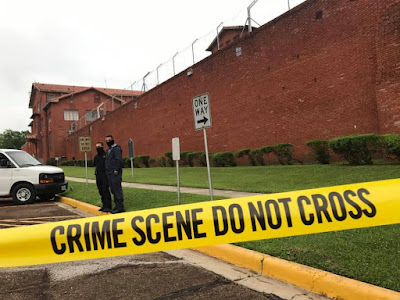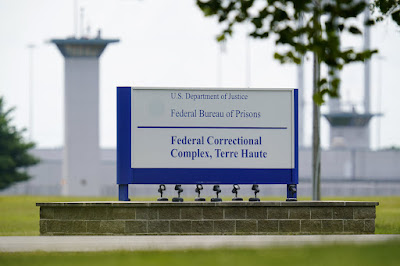 |
| The Walls Unit, Huntsville, Texas |
With 7 prisons, a cemetery for dead inmates and its infamous execution chamber, the business of detention and death is a way of life in the Texas town of Huntsville.
In this neat and tidy city north of Houston, prisoners recognizable by their white uniforms, maintain public green spaces under a blazing sun and the gaze of a guard, sitting on the edge of a car.
"These are trustees," says the corrections officer. The inmates in question are low-level criminals convicted of crimes such as car theft or burglary.
Out of Huntsville's population of 38,000 people, 14,000 are prisoners while a further 6,000 are guards or employees of the Texas Justice Department.
Instead of tourist signs pointing out antique shops, the tomb of famous Texas Governor Sam Houston, or other places of interest, a visitor is guided to the various prisons: the Wynne Unit, the Byrne Unit, Hollyday Unit.
"Prison, it's an industry here," says Kathreen Case, executive director of the Texas defender service. "It is their industry, it is amazing how many people can earn their lives out of it."
Prisons generate 16.6 million dollars in wages per month, while nearly 200 educators from the Windham School District contribute another 740,000 dollars each month to the local economy, according to the local Chamber of Commerce.
"It's a prison town, everybody knows somebody that works in the prison system," says Gloria Rubac, an activist who campaigns for the abolition of the death penalty in Texas. "It's a very prison-oriented town."
Prisoners are put to work in a number of schemes, doing everything from manufacturing their own clothes or the uniforms of prison guards to feeding and raising chickens.
"If we didn't have the prison system and if we didn't have the university, I don't know if you'd even have a traffic light in this town," said Jim Willett, former warden and commissioner at the Walls Unit, the oldest of 7 prisons.
An imposing building guarded by high red brick walls, the Walls Unit is set just a short distance from downtown Huntsville.
In the northeast corner of the building, topped by a watchtower, is the execution chamber, reveals Willett, who gave the green light to 89 executions in his 30-year career.
The clock on the facade of the building is the usual gathering point for anti-death penalty activists ahead of each execution.
They will gather again here Wednesday for the 500th execution scheduled since the reinstatement of the death penalty in the United States in 1976.
Previously, those sentenced to die were also imprisoned at the facility, but due to over-crowding amid soaring convictions, they were transferred to the Ellis Unit and later to the maximum security Polunsky Unit.
 |
| Polunsky Unit, Livingston, Texas |
A few hours before execution, the prisoner is taken from death row, a concrete fortress topped by razor wire where narrow slits are the only openings to the outside world, and transferred to the Huntsville execution chamber.
The condemned prisoner's final journey is a scenic route along the shores of Lake Livingston, surrounded by cedar forests. The precise route of a prisoner's final journey is never revealed for security reasons.
Since his retirement, Willett has taken over responsibility as curator for the Huntsville prison museum, one of the most popular stops on the tourist trail, where exhibits include the final words of those executed.
Pride of place is given to "Old Sparky" the nickname for the electric chair, which was responsible for sending 361 prisoners to their deaths before its use was discontinued in 1965.
Large syringes and straps on display reflect Texas's transition to the use of lethal injection as the preferred method of execution.
A gift shop sells mugs and T-shirts with death row symbols as well as novelty items notable for their black humor, including "Solitary Confine-mints."
A couple of blocks away is Hospitality House, a charitable organization run by 2 baptist pastors which aims to offer support to the families and loved ones of those who are condemned to death.
"The families shouldn't be punished," says Debra McCammon, the executive director of Hospitality House, describing them as "the other victims of crime."
It is also here that the prison chaplain prepares families in order to avoid "hysteria or panic" during executions.
A guided tour of the city's jails ends with the cemetery of prisoners, situated on a green hill shaded by sycamore trees.
Some 3,000 concrete crosses have been erected at the site since the 1st burials in the 19th century. Many graves are anonymous, while some are identified only by their prisoner number.
Others carry a single 1-word epitaph: "Executed."
Source: Global Post, June 23, 2013










.jpg)
